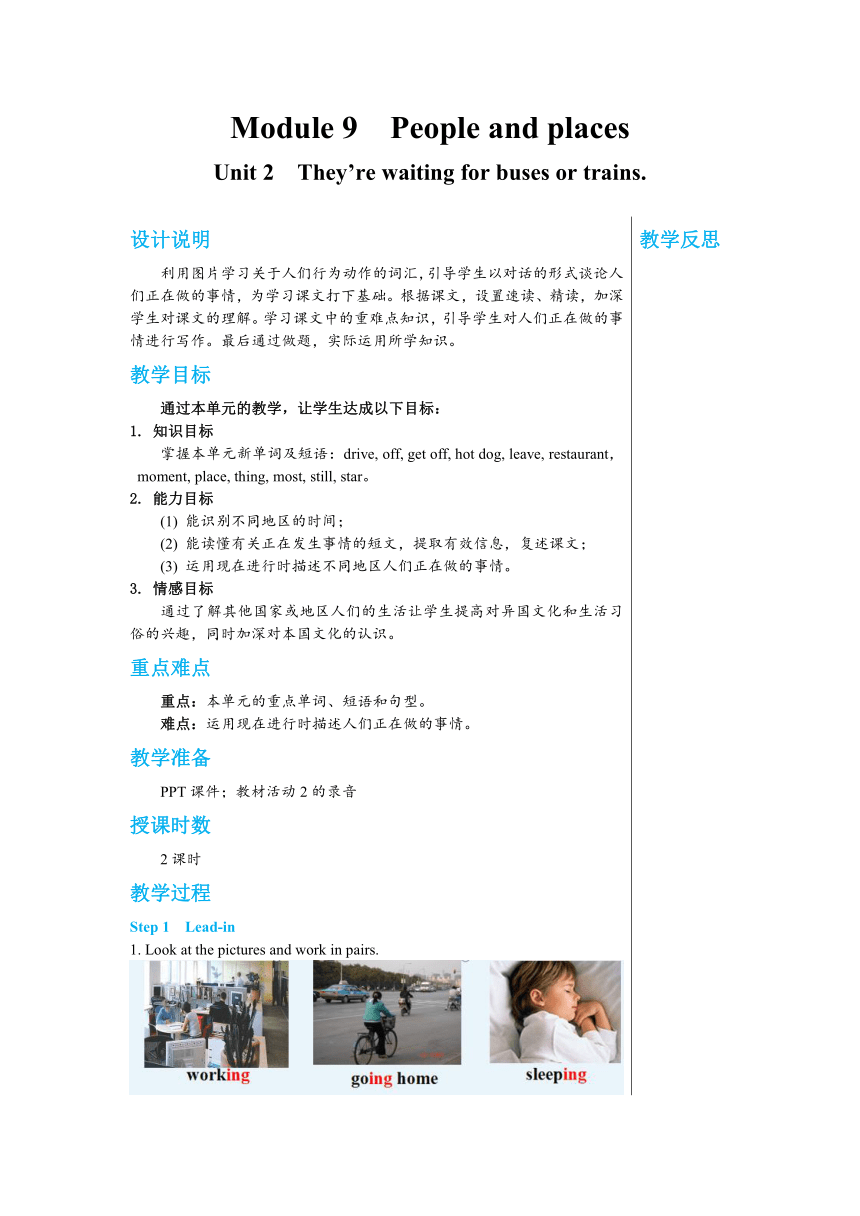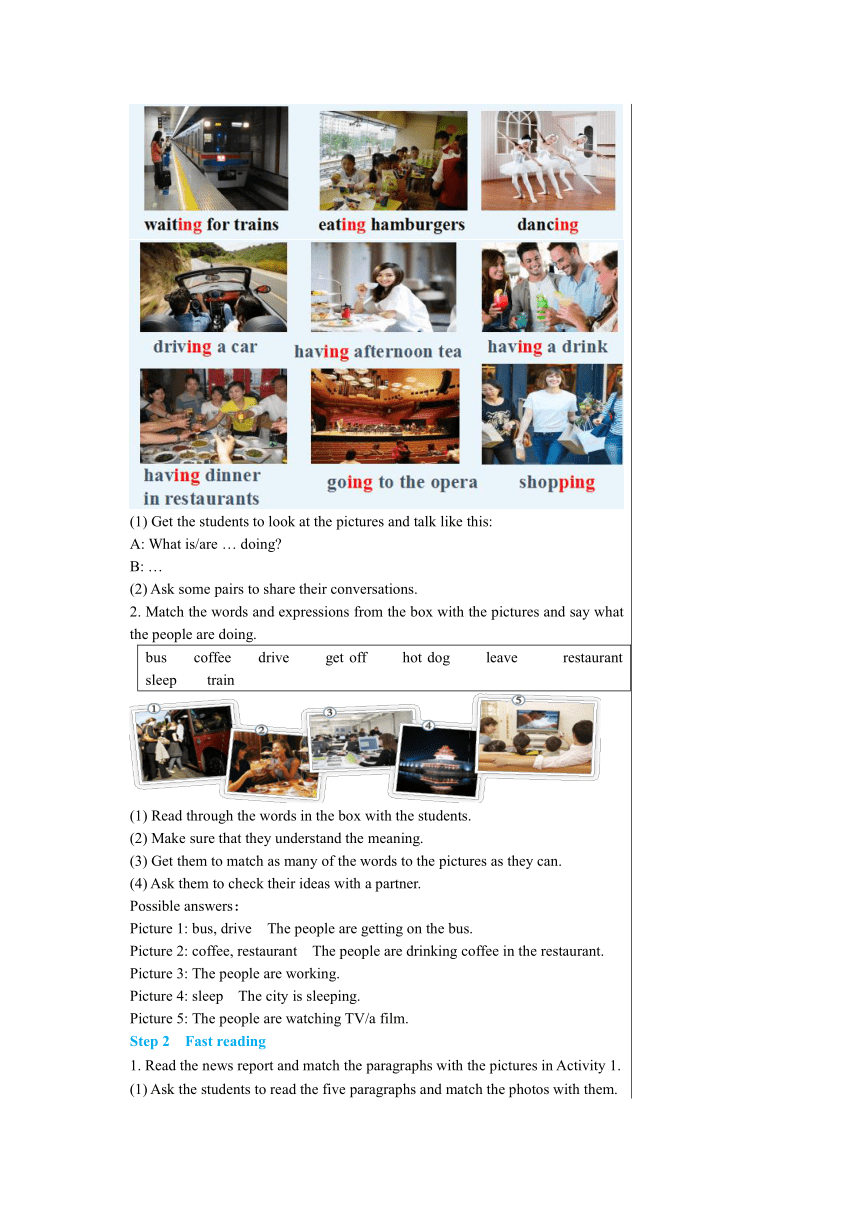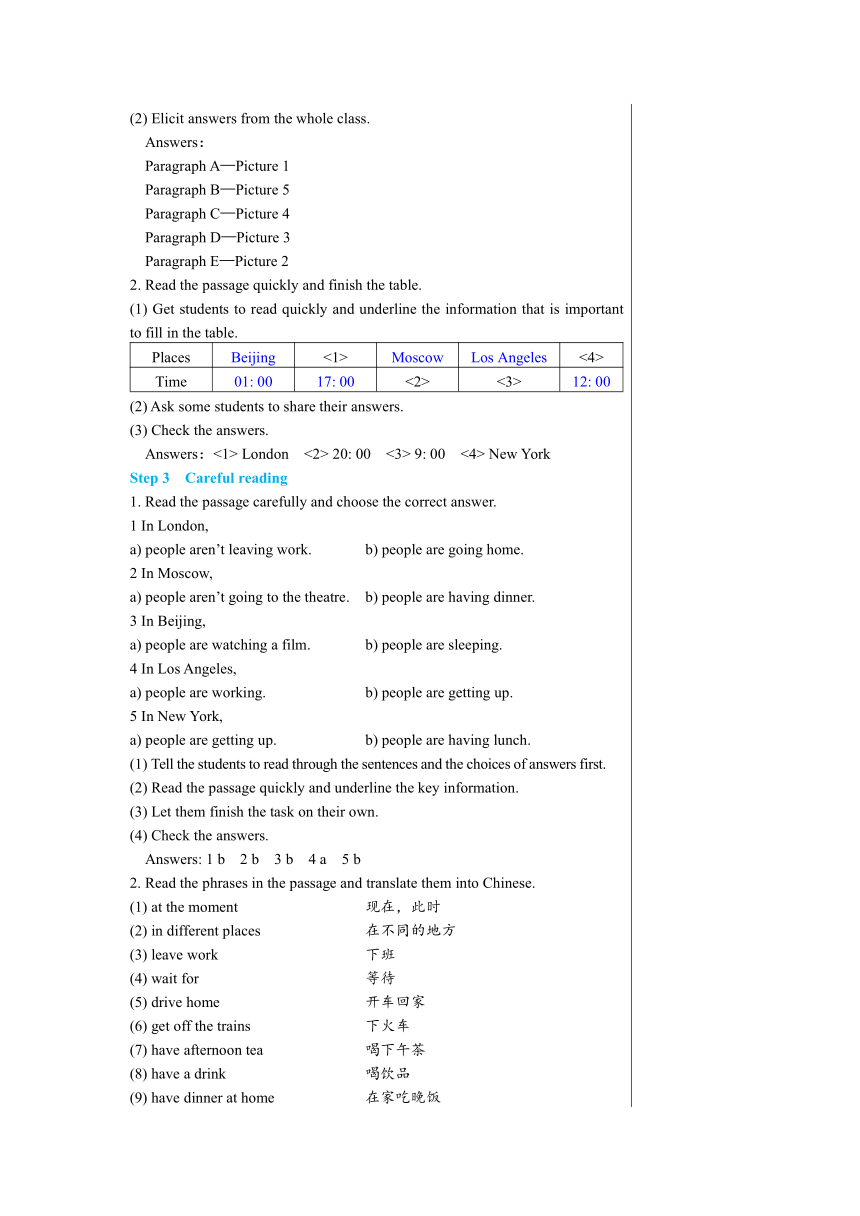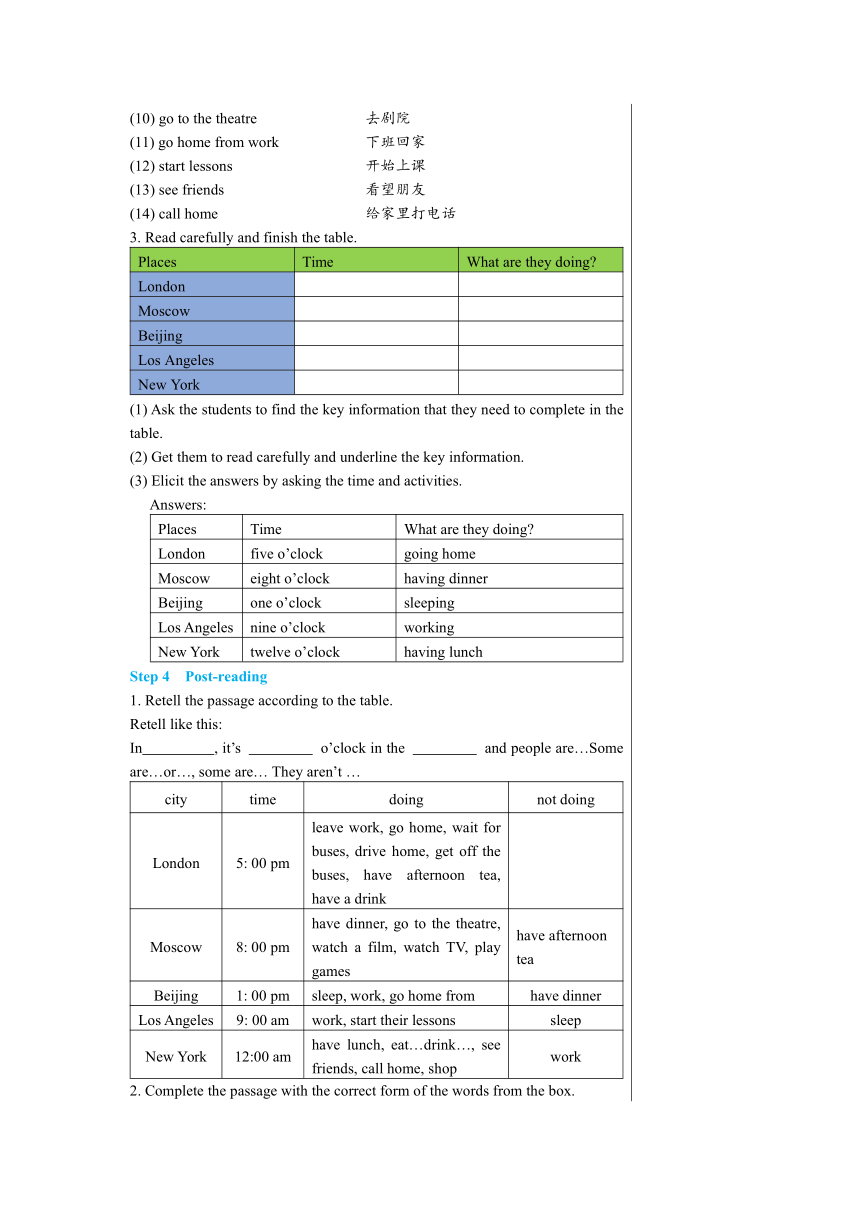外研版七年级上册 Module 9 People and places Unit 2教案
文档属性
| 名称 | 外研版七年级上册 Module 9 People and places Unit 2教案 |  | |
| 格式 | docx | ||
| 文件大小 | 877.2KB | ||
| 资源类型 | 教案 | ||
| 版本资源 | 外研版 | ||
| 科目 | 英语 | ||
| 更新时间 | 2022-11-24 12:40:49 | ||
图片预览




文档简介
Module 9 People and places
Unit 2 They’re waiting for buses or trains.
设计说明 利用图片学习关于人们行为动作的词汇,引导学生以对话的形式谈论人们正在做的事情,为学习课文打下基础。根据课文,设置速读、精读,加深学生对课文的理解。学习课文中的重难点知识,引导学生对人们正在做的事情进行写作。最后通过做题,实际运用所学知识。 教学目标 通过本单元的教学,让学生达成以下目标: 1. 知识目标 掌握本单元新单词及短语:drive, off, get off, hot dog, leave, restaurant,moment, place, thing, most, still, star。 2. 能力目标 (1) 能识别不同地区的时间; (2) 能读懂有关正在发生事情的短文,提取有效信息,复述课文; (3) 运用现在进行时描述不同地区人们正在做的事情。 3. 情感目标 通过了解其他国家或地区人们的生活让学生提高对异国文化和生活习俗的兴趣,同时加深对本国文化的认识。 重点难点 重点:本单元的重点单词、短语和句型。 难点:运用现在进行时描述人们正在做的事情。 教学准备 PPT课件;教材活动2的录音 授课时数 2课时 教学过程 Step 1 Lead-in 1. Look at the pictures and work in pairs. (1) Get the students to look at the pictures and talk like this: A: What is/are … doing B: … (2) Ask some pairs to share their conversations. 2. Match the words and expressions from the box with the pictures and say what the people are doing. bus coffee drive get off hot dog leave restaurant sleep train
(1) Read through the words in the box with the students. (2) Make sure that they understand the meaning. (3) Get them to match as many of the words to the pictures as they can. (4) Ask them to check their ideas with a partner. Possible answers: Picture 1: bus, drive The people are getting on the bus. Picture 2: coffee, restaurant The people are drinking coffee in the restaurant. Picture 3: The people are working. Picture 4: sleep The city is sleeping. Picture 5: The people are watching TV/a film. Step 2 Fast reading 1. Read the news report and match the paragraphs with the pictures in Activity 1. (1) Ask the students to read the five paragraphs and match the photos with them. (2) Elicit answers from the whole class. Answers: Paragraph A—Picture 1 Paragraph B—Picture 5 Paragraph C—Picture 4 Paragraph D—Picture 3 Paragraph E—Picture 2 2. Read the passage quickly and finish the table. (1) Get students to read quickly and underline the information that is important to fill in the table. PlacesBeijing<1>MoscowLos Angeles<4>Time01: 0017: 00<2><3>12: 00
(2) Ask some students to share their answers. (3) Check the answers. Answers:<1> London <2> 20: 00 <3> 9: 00 <4> New York Step 3 Careful reading 1. Read the passage carefully and choose the correct answer. 1 In London, a) people aren’t leaving work. b) people are going home. 2 In Moscow, a) people aren’t going to the theatre. b) people are having dinner. 3 In Beijing, a) people are watching a film. b) people are sleeping. 4 In Los Angeles, a) people are working. b) people are getting up. 5 In New York, a) people are getting up. b) people are having lunch. (1) Tell the students to read through the sentences and the choices of answers first. (2) Read the passage quickly and underline the key information. (3) Let them finish the task on their own. (4) Check the answers. Answers: 1 b 2 b 3 b 4 a 5 b 2. Read the phrases in the passage and translate them into Chinese. (1) at the moment 现在,此时 (2) in different places 在不同的地方 (3) leave work 下班 (4) wait for 等待 (5) drive home 开车回家 (6) get off the trains 下火车 (7) have afternoon tea 喝下午茶 (8) have a drink 喝饮品 (9) have dinner at home 在家吃晚饭 (10) go to the theatre 去剧院 (11) go home from work 下班回家 (12) start lessons 开始上课 (13) see friends 看望朋友 (14) call home 给家里打电话 3. Read carefully and finish the table. PlacesTimeWhat are they doing LondonMoscowBeijingLos AngelesNew York
(1) Ask the students to find the key information that they need to complete in the table. (2) Get them to read carefully and underline the key information. (3) Elicit the answers by asking the time and activities. Answers: PlacesTimeWhat are they doing Londonfive o’clockgoing homeMoscoweight o’clockhaving dinnerBeijingone o’clocksleepingLos Angelesnine o’clockworkingNew Yorktwelve o’clockhaving lunch
Step 4 Post-reading 1. Retell the passage according to the table. Retell like this: In , it’s o’clock in the and people are…Some are…or…, some are… They aren’t … citytimedoingnot doingLondon5: 00 pmleave work, go home, wait for buses, drive home, get off the buses, have afternoon tea, have a drinkMoscow8: 00 pmhave dinner, go to the theatre, watch a film, watch TV, play gameshave afternoon teaBeijing1: 00 pmsleep, work, go home fromhave dinnerLos Angeles9: 00 amwork, start their lessonssleepNew York12:00 amhave lunch, eat…drink…, see friends, call home, shopwork
2. Complete the passage with the correct form of the words from the box. (
moment most restaurant still thing
) All over the world, people are doing different (1) . At the (2) , it’s five o’clock in London and people are going home from work. People in Moscow are having dinner at home or in (3) . In Beijing, (4) people are sleeping, but some are (5) working. (1) Go through the words in the box with the students. (2) Ask them to read the passage and complete them with words in the box in pairs. (3) Elicit answers in full sentences from the class. Answers: (1) things (2) moment (3) restaurants (4) most (5) still Step 5 Language points 1. At this moment, in different places of the world, people are doing different things. 此时此刻,在世界上不同的地方,人们正在做不同的事情。 moment 是名词,意为“时刻,时候”。at the/this moment 意为“此时此刻”, 用于现在进行时,与now或right now同义。 What is he doing at the moment 此时此刻他正在做什么? [拓展] (1) moment 还可意为“片刻,瞬间” Wait a moment, please. 请稍等一下。 (2) in a moment 马上,很快 I’ll be back in a moment. 我马上回来。 2. In London, it’s five o’clock in the afternoon and people are leaving work and are going home. 在伦敦,现在是下午五点,人们正在下班回家。 leave 是动词,意为“离开”,leave work 意为“下班”。leave for… 意为“前往某地”。 It’s time for us to leave. 我们该走了。 My grandmother wants to leave for Beijing tomorrow. 我的祖母明天想去北京。 [拓展] leave 还可表示“留下,留给,把……忘在某处”,后面常与表示地点的介词短语连用。 He usually leaves his homework at home. 他经常把作业落在家里。 3. Some people are driving home. 一些人在开车回家。 drive是动词,意为“驾驶;驾车”。 drive to… 意为“开车去某地”, 当后面接here, there, home 等时,不带to。 Don’t drive too fast! 不要开车太快! He drives to work every day. 他每天开车去上班。 [拓展] driver是名词,意为“司机”。 My father is a driver; he often drives us to travel. 我的爸爸是一位司机,他经常开车带我们去旅行。 4. Some are getting off buses or trains. 一些人正在下公交车或火车。 get off 意为“下 (飞机、火车、公共汽车等) ” , 其反义短语为get on, 意为“上 (飞机、火车、公共汽车等) ” 。 Get off the bus at the next stop. 在下一站下车。 Do all the students get on the school bus 所有的学生都上校车了吗? 5. Most people are sleeping. 大部分人在睡觉。 most此处作形容词,意为“大部分 (的) ; 大多数 (的) ”。 (1) most+名词,泛指多数,无范围。 Most children like eating ice cream. 大多数孩子喜欢吃冰激凌。 (2) “most of + the/ this/ these/ that/ those/ 物主代词+名词”或 “most of + 代词”,指某一范围以内的多数。 Most of the students in my class are from countryside. 我班里大多数的学生来自农村。 Step 6 Writing 1. Find out what time it is now in London, Moscow, New York and Los Angeles. Write sentences about what people are doing or aren’t doing. Join sentences with and or so. In London, it’s… and people are leaving… In Beijing, it’s…, so people aren’t… 2. Read the postcard and check (√) the true sentences. Dear Betty, Hi from Los Angeles! Thank you for your postcard from the Great Wall. Please send a card to Grandma. I’m visiting my friends in Hollywood at the moment and I’m enjoying the sun! We’re in front of a cinema in Hollywood and I’m writing this postcard to you. We’re looking at the homes of the movie stars. I’m taking lots of photos. See you next week! Love, Mum Betty King No. 19 Xisanhuan Beilu Beijing (100089) P. R. China
1 This is a postcard from Betty’s mum. □ 2 Betty’s mum is visiting her friends in Hollywood. □ 3 Betty is enjoying the movie. □ 4 Betty’s mum is taking a lot of photos. □ (1) Ask the students to read the sentences and then read the postcard. (2) Get them to underline key information, and then check the true sentences individually. (3) Students check answers in pairs and give reason if false. (4) Elicit answers from the whole class. Answers: 1 √ 2 √ 3× 4 √ 3. Write Betty’s postcard to her grandma from the Great Wall. ·Start like this: Dear Grandma, ·Say what she’s doing now. ·Say what she’s enjoying. ·Finish like this : Love , Betty Answer (just for reference) : Dear Grandma, I’m writing this postcard to you on the Great Wall! I’m visiting it with my classmates and we’re enjoying the trip a lot. Wang Hui is taking lots of photos and Lingling is buying a few postcards and presents. The teacher is talking to us about the history of the Wall. Love, Betty Step 7 Homework 1. Read the passage. 2. Try to retell paragraphs according to the table. 当堂达标 Ⅰ. 用所给单词的适当形式填空。 1. Thank you very much for (help) me. 2. My mother (drive) her car to work every day. 3. Lingling is watching TV in the room and her mother (wash) clothes. 4. My best friend likes watching TV a lot. He (not watch) TV now. He usually (watch) TV at home. 5. —What you (talk) about —We are talking about my new bike. Ⅱ. 单项填空。 1. Sometimes in different of the world people are doing thing. A. place, the same B. places, same C. place, same D. places, the same 2. You . Don’t talk on the phone. A. will drive B. are driving C. were driving D. is driving 3. —Where is your cousin —He an English exam now. A. has B. had C. having D. is having 4. —What are your parents doing now —They afternoon tea. A. are having B. have C. having D. drinking 5. —Betty is ill today. Is she in bed —Yes, she . A. lie, am B. lay, are C. lying, be D. lying, is III. 翻译句子。 1. 现在是下午五点,人们正在下班并且回家。 ______________________________________________________________ 2. 人们此时正在下公交车或火车吗? ______________________________________________________________ 3. 一些人正在去剧院或看电影。 ______________________________________________________________ 4. 孩子们正在上课。 ______________________________________________________________ 答案:Ⅰ. 1. helping 2. drives 3. is washing 4. isn’t watching, watches 5. are , talking Ⅱ. 1-5 DBDAD Ⅲ. 1. It’s five o’clock in the afternoon. People are leaving work and are going home. 2. Are people getting off buses or trains at this moment 3. Some people are going to the theater or watching a film. 4. Children are starting their lessons. 板书设计 Module 9 People and places Unit 2 They’re waiting for buses or trains. 1. at the/this moment用于现在进行时 2. leave work下班 3. drive to …开车去…… 4. get off 下 (飞机、火车、公共汽车等) get on上 (飞机、火车、公共汽车等) 5. most+名词 泛指多数,无范围。 most of + the/ this/ these/ that/ those/ 物主代词+名词 指某一范围以内的多数。
教学反思
Unit 2 They’re waiting for buses or trains.
设计说明 利用图片学习关于人们行为动作的词汇,引导学生以对话的形式谈论人们正在做的事情,为学习课文打下基础。根据课文,设置速读、精读,加深学生对课文的理解。学习课文中的重难点知识,引导学生对人们正在做的事情进行写作。最后通过做题,实际运用所学知识。 教学目标 通过本单元的教学,让学生达成以下目标: 1. 知识目标 掌握本单元新单词及短语:drive, off, get off, hot dog, leave, restaurant,moment, place, thing, most, still, star。 2. 能力目标 (1) 能识别不同地区的时间; (2) 能读懂有关正在发生事情的短文,提取有效信息,复述课文; (3) 运用现在进行时描述不同地区人们正在做的事情。 3. 情感目标 通过了解其他国家或地区人们的生活让学生提高对异国文化和生活习俗的兴趣,同时加深对本国文化的认识。 重点难点 重点:本单元的重点单词、短语和句型。 难点:运用现在进行时描述人们正在做的事情。 教学准备 PPT课件;教材活动2的录音 授课时数 2课时 教学过程 Step 1 Lead-in 1. Look at the pictures and work in pairs. (1) Get the students to look at the pictures and talk like this: A: What is/are … doing B: … (2) Ask some pairs to share their conversations. 2. Match the words and expressions from the box with the pictures and say what the people are doing. bus coffee drive get off hot dog leave restaurant sleep train
(1) Read through the words in the box with the students. (2) Make sure that they understand the meaning. (3) Get them to match as many of the words to the pictures as they can. (4) Ask them to check their ideas with a partner. Possible answers: Picture 1: bus, drive The people are getting on the bus. Picture 2: coffee, restaurant The people are drinking coffee in the restaurant. Picture 3: The people are working. Picture 4: sleep The city is sleeping. Picture 5: The people are watching TV/a film. Step 2 Fast reading 1. Read the news report and match the paragraphs with the pictures in Activity 1. (1) Ask the students to read the five paragraphs and match the photos with them. (2) Elicit answers from the whole class. Answers: Paragraph A—Picture 1 Paragraph B—Picture 5 Paragraph C—Picture 4 Paragraph D—Picture 3 Paragraph E—Picture 2 2. Read the passage quickly and finish the table. (1) Get students to read quickly and underline the information that is important to fill in the table. PlacesBeijing<1>MoscowLos Angeles<4>Time01: 0017: 00<2><3>12: 00
(2) Ask some students to share their answers. (3) Check the answers. Answers:<1> London <2> 20: 00 <3> 9: 00 <4> New York Step 3 Careful reading 1. Read the passage carefully and choose the correct answer. 1 In London, a) people aren’t leaving work. b) people are going home. 2 In Moscow, a) people aren’t going to the theatre. b) people are having dinner. 3 In Beijing, a) people are watching a film. b) people are sleeping. 4 In Los Angeles, a) people are working. b) people are getting up. 5 In New York, a) people are getting up. b) people are having lunch. (1) Tell the students to read through the sentences and the choices of answers first. (2) Read the passage quickly and underline the key information. (3) Let them finish the task on their own. (4) Check the answers. Answers: 1 b 2 b 3 b 4 a 5 b 2. Read the phrases in the passage and translate them into Chinese. (1) at the moment 现在,此时 (2) in different places 在不同的地方 (3) leave work 下班 (4) wait for 等待 (5) drive home 开车回家 (6) get off the trains 下火车 (7) have afternoon tea 喝下午茶 (8) have a drink 喝饮品 (9) have dinner at home 在家吃晚饭 (10) go to the theatre 去剧院 (11) go home from work 下班回家 (12) start lessons 开始上课 (13) see friends 看望朋友 (14) call home 给家里打电话 3. Read carefully and finish the table. PlacesTimeWhat are they doing LondonMoscowBeijingLos AngelesNew York
(1) Ask the students to find the key information that they need to complete in the table. (2) Get them to read carefully and underline the key information. (3) Elicit the answers by asking the time and activities. Answers: PlacesTimeWhat are they doing Londonfive o’clockgoing homeMoscoweight o’clockhaving dinnerBeijingone o’clocksleepingLos Angelesnine o’clockworkingNew Yorktwelve o’clockhaving lunch
Step 4 Post-reading 1. Retell the passage according to the table. Retell like this: In , it’s o’clock in the and people are…Some are…or…, some are… They aren’t … citytimedoingnot doingLondon5: 00 pmleave work, go home, wait for buses, drive home, get off the buses, have afternoon tea, have a drinkMoscow8: 00 pmhave dinner, go to the theatre, watch a film, watch TV, play gameshave afternoon teaBeijing1: 00 pmsleep, work, go home fromhave dinnerLos Angeles9: 00 amwork, start their lessonssleepNew York12:00 amhave lunch, eat…drink…, see friends, call home, shopwork
2. Complete the passage with the correct form of the words from the box. (
moment most restaurant still thing
) All over the world, people are doing different (1) . At the (2) , it’s five o’clock in London and people are going home from work. People in Moscow are having dinner at home or in (3) . In Beijing, (4) people are sleeping, but some are (5) working. (1) Go through the words in the box with the students. (2) Ask them to read the passage and complete them with words in the box in pairs. (3) Elicit answers in full sentences from the class. Answers: (1) things (2) moment (3) restaurants (4) most (5) still Step 5 Language points 1. At this moment, in different places of the world, people are doing different things. 此时此刻,在世界上不同的地方,人们正在做不同的事情。 moment 是名词,意为“时刻,时候”。at the/this moment 意为“此时此刻”, 用于现在进行时,与now或right now同义。 What is he doing at the moment 此时此刻他正在做什么? [拓展] (1) moment 还可意为“片刻,瞬间” Wait a moment, please. 请稍等一下。 (2) in a moment 马上,很快 I’ll be back in a moment. 我马上回来。 2. In London, it’s five o’clock in the afternoon and people are leaving work and are going home. 在伦敦,现在是下午五点,人们正在下班回家。 leave 是动词,意为“离开”,leave work 意为“下班”。leave for… 意为“前往某地”。 It’s time for us to leave. 我们该走了。 My grandmother wants to leave for Beijing tomorrow. 我的祖母明天想去北京。 [拓展] leave 还可表示“留下,留给,把……忘在某处”,后面常与表示地点的介词短语连用。 He usually leaves his homework at home. 他经常把作业落在家里。 3. Some people are driving home. 一些人在开车回家。 drive是动词,意为“驾驶;驾车”。 drive to… 意为“开车去某地”, 当后面接here, there, home 等时,不带to。 Don’t drive too fast! 不要开车太快! He drives to work every day. 他每天开车去上班。 [拓展] driver是名词,意为“司机”。 My father is a driver; he often drives us to travel. 我的爸爸是一位司机,他经常开车带我们去旅行。 4. Some are getting off buses or trains. 一些人正在下公交车或火车。 get off 意为“下 (飞机、火车、公共汽车等) ” , 其反义短语为get on, 意为“上 (飞机、火车、公共汽车等) ” 。 Get off the bus at the next stop. 在下一站下车。 Do all the students get on the school bus 所有的学生都上校车了吗? 5. Most people are sleeping. 大部分人在睡觉。 most此处作形容词,意为“大部分 (的) ; 大多数 (的) ”。 (1) most+名词,泛指多数,无范围。 Most children like eating ice cream. 大多数孩子喜欢吃冰激凌。 (2) “most of + the/ this/ these/ that/ those/ 物主代词+名词”或 “most of + 代词”,指某一范围以内的多数。 Most of the students in my class are from countryside. 我班里大多数的学生来自农村。 Step 6 Writing 1. Find out what time it is now in London, Moscow, New York and Los Angeles. Write sentences about what people are doing or aren’t doing. Join sentences with and or so. In London, it’s… and people are leaving… In Beijing, it’s…, so people aren’t… 2. Read the postcard and check (√) the true sentences. Dear Betty, Hi from Los Angeles! Thank you for your postcard from the Great Wall. Please send a card to Grandma. I’m visiting my friends in Hollywood at the moment and I’m enjoying the sun! We’re in front of a cinema in Hollywood and I’m writing this postcard to you. We’re looking at the homes of the movie stars. I’m taking lots of photos. See you next week! Love, Mum Betty King No. 19 Xisanhuan Beilu Beijing (100089) P. R. China
1 This is a postcard from Betty’s mum. □ 2 Betty’s mum is visiting her friends in Hollywood. □ 3 Betty is enjoying the movie. □ 4 Betty’s mum is taking a lot of photos. □ (1) Ask the students to read the sentences and then read the postcard. (2) Get them to underline key information, and then check the true sentences individually. (3) Students check answers in pairs and give reason if false. (4) Elicit answers from the whole class. Answers: 1 √ 2 √ 3× 4 √ 3. Write Betty’s postcard to her grandma from the Great Wall. ·Start like this: Dear Grandma, ·Say what she’s doing now. ·Say what she’s enjoying. ·Finish like this : Love , Betty Answer (just for reference) : Dear Grandma, I’m writing this postcard to you on the Great Wall! I’m visiting it with my classmates and we’re enjoying the trip a lot. Wang Hui is taking lots of photos and Lingling is buying a few postcards and presents. The teacher is talking to us about the history of the Wall. Love, Betty Step 7 Homework 1. Read the passage. 2. Try to retell paragraphs according to the table. 当堂达标 Ⅰ. 用所给单词的适当形式填空。 1. Thank you very much for (help) me. 2. My mother (drive) her car to work every day. 3. Lingling is watching TV in the room and her mother (wash) clothes. 4. My best friend likes watching TV a lot. He (not watch) TV now. He usually (watch) TV at home. 5. —What you (talk) about —We are talking about my new bike. Ⅱ. 单项填空。 1. Sometimes in different of the world people are doing thing. A. place, the same B. places, same C. place, same D. places, the same 2. You . Don’t talk on the phone. A. will drive B. are driving C. were driving D. is driving 3. —Where is your cousin —He an English exam now. A. has B. had C. having D. is having 4. —What are your parents doing now —They afternoon tea. A. are having B. have C. having D. drinking 5. —Betty is ill today. Is she in bed —Yes, she . A. lie, am B. lay, are C. lying, be D. lying, is III. 翻译句子。 1. 现在是下午五点,人们正在下班并且回家。 ______________________________________________________________ 2. 人们此时正在下公交车或火车吗? ______________________________________________________________ 3. 一些人正在去剧院或看电影。 ______________________________________________________________ 4. 孩子们正在上课。 ______________________________________________________________ 答案:Ⅰ. 1. helping 2. drives 3. is washing 4. isn’t watching, watches 5. are , talking Ⅱ. 1-5 DBDAD Ⅲ. 1. It’s five o’clock in the afternoon. People are leaving work and are going home. 2. Are people getting off buses or trains at this moment 3. Some people are going to the theater or watching a film. 4. Children are starting their lessons. 板书设计 Module 9 People and places Unit 2 They’re waiting for buses or trains. 1. at the/this moment用于现在进行时 2. leave work下班 3. drive to …开车去…… 4. get off 下 (飞机、火车、公共汽车等) get on上 (飞机、火车、公共汽车等) 5. most+名词 泛指多数,无范围。 most of + the/ this/ these/ that/ those/ 物主代词+名词 指某一范围以内的多数。
教学反思
同课章节目录
- Starte
- Module 1 My teacher and my friends
- Module 2 My English lesson
- Module 3 My English book
- Module 4 My everyday life
- Module 1 My classmates
- Unit 1 Nice to meet you.
- Unit 2 I'm Wang Lingling and I'm thirteen years ol
- Unit 3 Language in use.
- Module 2 My family
- Unit 1 Is this your mum?
- Unit 2 These are my parents.
- Unit 3 Language in use.
- Module 3 My school
- Unit 1 There are thirty students in my class.
- Unit 2 The library is on the left of the playgroun
- Unit 3 Language in use.
- Module 4 Healthy food
- Unit 1 We've got lots of apples.
- Unit 2 Is your food and drink healthy?
- Unit 3 Language in use.
- Module 5 My school day
- Unit 1 I love history.
- Unit 2 We start work at nine o'clock.
- Unit 3 Language in use.
- Revision module A
- Module 6 A trip to the zoo
- Unit 1 Does it eat meat?
- Unit 2 The tiger lives in Asia.
- Unit 3 Language in use.
- Module 7 Computers
- Unit 1 How do I write my homework on the computer?
- Unit 2 When do you use a computer?
- Unit 3 Language in use.
- Module 8 Choosing presents
- Unit 1 I always like birthday parties.
- Unit 2 She often goes to concerts.
- Unit 3 Language in use.
- Module 9 People and places
- Unit 1 We're enjoying the school trip a lot.
- Unit 2 They're waiting for buses or trains.
- Unit 3 Language in use.
- Module 10 Spring Festival
- Unit 1 Are you getting ready for Spring Festival?
- Unit 2 My mother's cleaning our houses and sweepin
- Unit 3 Language in use.
- Revision module B
